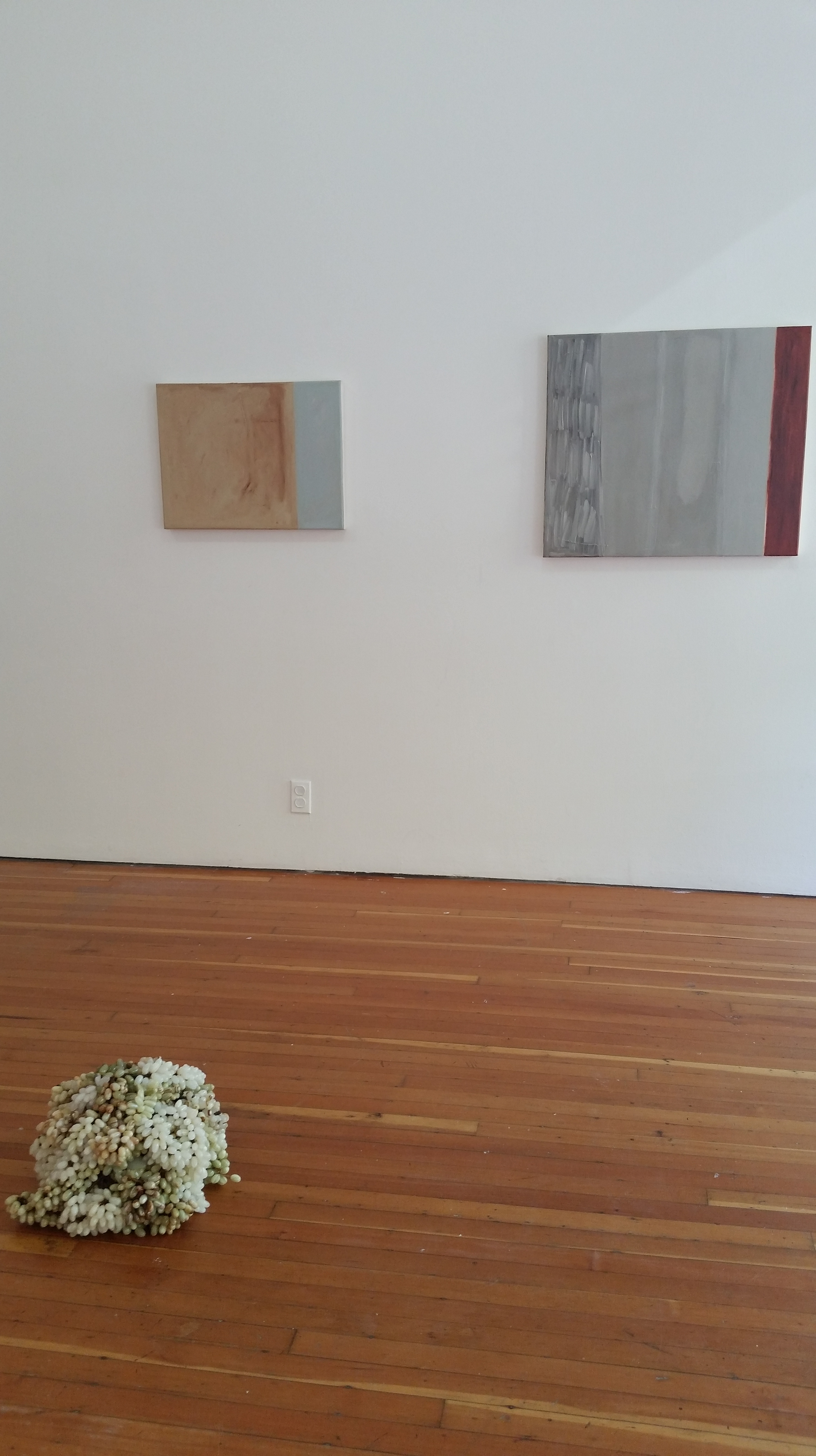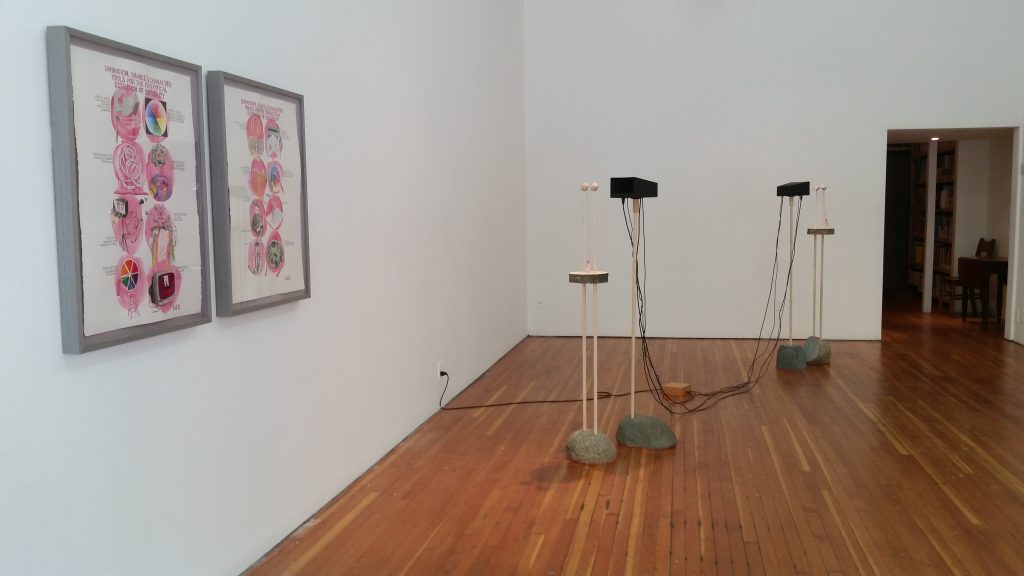The Affect of Accursedness
7 July 2016
By Lauren Lavery
Hosted at Artspeak gallery in April of this year, The Accursed Share was an exhibition featuring the work of artists Aleesa Cohene, Deborah Edmeades and Derek Dunlop. The exhibition was guest curated by Marina Roy, a Vancouver-based artist, writer and curator whose interest lies in the intersection between language and art, thus making the use of the word accursed an intriguing choice, considering its reference to the essays by George Bataille aptly titled, The Accursed Share (La part maudite) from 1949.
While this underlying cynicism is not obviously apparent in Roy’s choice of artists and their practices, it is in her reference to Bataille and his particular body of work where it lies. The book is based upon his economics-positioned definition that a so-called ‘fulfilling existence’ for an organism would be that energy and labour should only be outputted in order to accomplish productive modes for existing. In short, if an organism’s (or object’s) energy expenditure does not have a so-called ‘productive’ purpose, then it is being wasted. If this is not already presupposing enough, it is especially interesting in relation to works of art, whose value and purpose are often centralized around the story of the maker’s intent, as well as the immortal nature that an inorganic makeup provides – an impression which coloured the works in the exhibition with an innuendo of suspicion on the ways in which we encounter art.
Upon first encountering The Accursed Share, the viewer is immediately confronted with a small floor sculpture titled You, Dear (2014)—which is no larger than a curled-up, snoozing house cat. Resembling an oversized, ornamental grape bunch more than anything mammalian, the piece possessed an uncanny sort of alive-ness beyond that of a mere cluster of fruit.
Bending down for further inspection of the sculpture’s details, the final curious oddity of Cohene’s work presents itself: a musky scent emanating from its interior. Although the smell is detectable, it is subtle and could be missed without careful consideration (or careful inhalation, perhaps). “Diffused scent” is labelled under the work’s material list, but in keeping with this sense of ambiguity—could the production of its scent then be considered a “squandering of energy” since there is not an apparent use-value for the sculpture’s labour? Is the act of diffusion accomplishing a productive and significant enough justification for its existence, or is it merely just for art’s-sake? The scent and the production thereof undoubtedly gives the small and seemingly fragile piece a new life beyond its static materiality.

The earthy brown tones of the onyx in the sculpture were also reflected in many of the paintings by Derek Dunlop, whose five works were installed in a row on the right facing wall, with the exception of M (2015), holding its own on the opposite side. All of Dunlop’s paintings were rather modest in their size – an interesting break from larger abstract monochromes whose reliance on scale lessens the importance of smaller details. The sensibilities of a smaller working space left room for more minimal gestures to be exaggerated, which also allowed for a greater amount of works to engage in the conversation.
What I found most interesting about the paintings as a group was their familiarity with one another, as if their interactions and relationships seemed deeper than mere correlations of colour and texture. The installation of the paintings only aided this reading, as they were hung in a less than conventional manner. For example, Bullrushes (2015) and Eternal Return (2015) had only a few centimetres between them while Sully (2015) was solitarily placed about a metre away from the pair. The smaller scale of the works allowed for the paintings to play their similar colours, textures and shapes off of each other, inviting a more approachable and spirited interaction between the paintings and the viewer. The captivating size and placement of the paintings were reminiscent of the strange-yet-familiar nature of Cohene’s You, Dear, all of which accordingly renewed the viewing experience through challenging the expectations of the viewer, and trace back to the roots of the accursed: the works offer a resistance to the standard modes of looking.
This resistance was finalized with the consideration of the two remaining works in the exhibition by Deborah Edmeades, a pair of mixed-media drawings titled Divination, Chance and Character: Tools for the Extension of Sensibility (Index) (2016) and a fantastical sculptural installation suitably named Blinking and Other Involuntary Portals (2016). The latter of which was, quite literally, the most animate piece exhibited. Composed of two hyper-feminine (think extremely exaggerated, sparkly lashes) eyeballs blinking back and forth across a divide, only connected through a mirrored “portal” which reflected the opposite eye’s movements. Similar to Cohene’s sculpture, Blinking and Other Involuntary Portals also defined the notion of wasted energy through its mechanized movements as well as its interaction with Edmeades’ corresponding wall works. These drawings allude to her ongoing artistic explorations, while also self-referencing the sculptural installation sitting just beside them, thus forming an inter-connected viewing entanglement between art and viewer that formalizes the resistance to a singular-objectness. In this way, the entire exhibition acted as an affectual playground in which each singular object could not be read alone, for the combined significance of the show outweighed such individualism.
What I found bound the works together, despite their inherent material differences, was not necessarily just the notion of their accursedness, but rather the consideration of how the works affected one another. Although the literally animated works were able to make more of a direct and physical impact on the viewer, the stationary works were also bound to this affectedness through a universal correlation to something inherently painful: a notion that all material things have an end. Each work and its unique compositional elements will eventually erode in their own ways, and with them their many wasted hours of labouring, existing, being. In a society in which material objects are valued higher for their commodifiable nature, it makes sense then that an object which so evidently displays its mortality would disrupt this mode of thinking, and in turn make us question our own fate, our own materiality, our own accursedness. If this is true, then perhaps existing without a commodifiable or productive purpose is also a squandering of energy. But where does that lead us, as viewers, viewing such unproductive materials of existence? As existential as this may be, perhaps materiality is not where value truly lies, but rather in the way in which art has, and continues to affect us.



